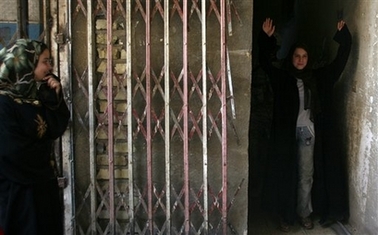Death toll in Iraq blasts rises to 250
Updated: 2007-08-16 11:05
BAGHDAD -- Rescuers used bare hands and shovels Wednesday to claw through clay houses shattered by an onslaught of suicide bombings that killed at least 250 and possibly as many as 500 members of an ancient religious sect in the deadliest attack of the Iraq war.
 An Iraqi girl is searched by a female US Army soldier (obscured) from Alpha Company, 1st Battalion, 5th Cavalry Regiment, 2nd Brigade, 1st Cavalry Division at a checkpoint in the Amariyah neighborhood of west Baghdad, Iraq on Wednesday, Aug. 15, 2007. [AP] |
The US military is looking at Al-Qaida as "the prime suspect".
The victims of Tuesday night's coordinated attack by four suicide bombers were Yazidis, a small Kurdish-speaking sect that has been targeted by Muslim extremists who consider its members to be blasphemers.
The blasts in two villages near the Syrian border crumbled buildings, trapping entire families beneath mud bricks and other wreckage. Entire neighborhoods were flattened.
"This is an act of ethnic cleansing, if you will, almost genocide," Army Maj. Gen. Benjamin Mixon, commander of US forces in northern Iraq, told CNN. He said that was evident from the fact Yazidis live in a remote part of Ninevah Province that has been far from Iraq's conflict.
Mixon said last month that he proposed reducing American troop levels in Ninevah and predicted the province would shift to Iraqi government control as early as this month. It was unclear whether that projection would hold after Tuesday's staggering casualties.
Death estimates ranged widely.
|
|||
But the death toll was put as high as 500 by some local officials, including Hashim al-Hamadani, a senior provincial security official; Kifah Mohammed, director of Sinjar hospital; and Iraqi army Capt. Mohammed Ahmed. They agreed with Othman that about 350 were wounded.
None of the officials provided information on how they arrived at their estimates. The figures could not be independently checked because the area was under curfew and casualties had been taken to numerous hospitals.
Even the lower death estimate far surpassed the previous bloodiest attack of the war — 215 people killed by mortar fire and five car bombs in Baghdad's Shiite Muslim enclave of Sadr City last November 23.
US officials believe insurgents have been regrouping across northern Iraq after being driven from strongholds in and around Baghdad, and the bombings coincided with the start of a major offensive by American and Iraqi troops against militants in the Diyala River Valley.
The carnage dealt a serious blow to the Bush administrations hopes of presenting a positive picture in a progress report on Iraq to be delivered by the top US commander, Gen. David Petraeus, and US Ambassador Ryan Crocker in about four weeks.
Petraeus warned that he expected Sunni Arab insurgents to stage more spectacular attacks ahead of the report to Congress, whose members are deeply divided over whether to begin withdrawing US troops from Iraq.
|
|
|
||
|
||
|
|
|
|






